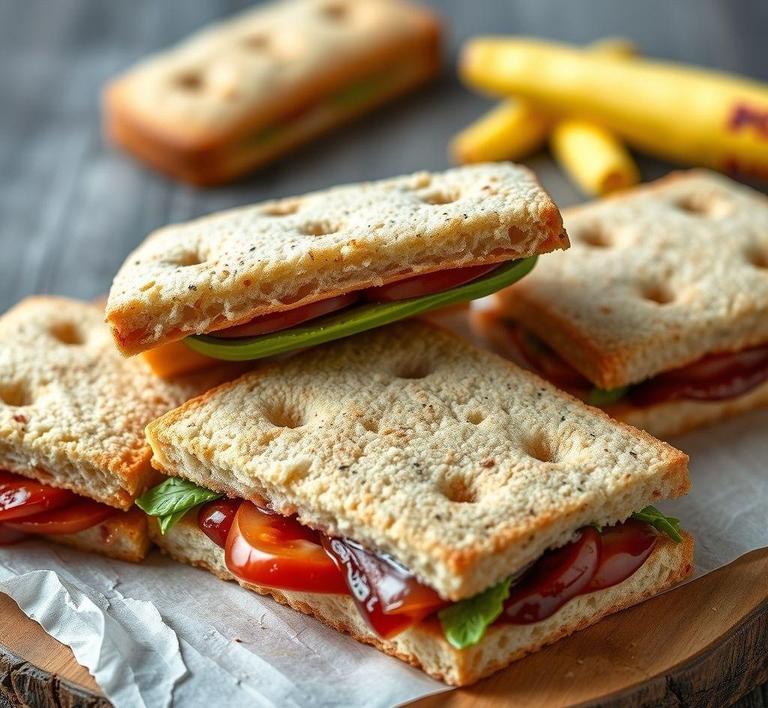If you’ve ever found yourself with a bunch of leftover Uncrustables sandwiches and wondered whether you could refreeze them for later, you’re not alone! Refreezing Uncrustables can actually be a convenient way to keep them fresh and ready for when you need a quick snack or meal. The process isn’t too complicated, but there are a few key tips to ensure that the sandwiches maintain their flavor and texture after being frozen again. In this guide, we’ll walk you through everything you need to know to properly refreeze Uncrustables sandwiches so that you can enjoy them just as delicious as the first time around!
Can You Refreeze Uncrustables Sandwiches?

When it comes to storing and preserving the freshness of foods, especially pre-packaged products like Uncrustables sandwiches, one of the common questions that pops up is whether it’s safe or advisable to refreeze them. Uncrustables, those conveniently frozen peanut butter and jelly sandwiches made by Smucker’s, have become a popular go-to snack or lunch option. The ease of storing them in the freezer, pulling them out when needed, and not worrying about making a sandwich from scratch has made these little pockets of joy a favorite for both kids and adults alike.
However, freezing and refreezing food is a bit of a gray area. In the case of Uncrustables, refreezing them is technically possible, but there are some important factors to consider when it comes to both food safety and quality. The key here is understanding what happens when food is frozen, thawed, and then frozen again. While freezing halts the growth of bacteria, it doesn’t kill them, which means that, if mishandled, there can be an increased risk of foodborne illnesses.
How To Refreeze Uncrustables Sandwiches?
If you find yourself with leftover Uncrustables after defrosting, or you simply want to extend their shelf life, you can refreeze them-but it’s essential to do so correctly. Refreezing isn’t as straightforward as simply throwing them back in the freezer; it requires a little attention to detail to preserve their taste and texture. Here’s a step-by-step guide to properly refreezing Uncrustables sandwiches:
- Ensure Proper Thawing: First and foremost, you should only refreeze Uncrustables after they have been thawed in the fridge, not at room temperature. Letting them sit out on the counter for long periods can encourage bacterial growth, which makes the food unsafe. Always thaw Uncrustables overnight in the fridge, as this keeps the sandwiches at a consistent, cool temperature, preventing any potential food safety issues.
- Check for Quality Before Refreezing: After thawing, check the quality of the Uncrustables. If there’s any visible signs of spoilage like an off-smell, discoloration, or mold, discard them. Refreezing spoiled food is dangerous, so it’s important to ensure the sandwich is still in good condition.
- Wrap Them Well: Uncrustables are designed to be individually wrapped, but after thawing, their outer packaging might be compromised or less secure. To prevent freezer burn and protect the sandwiches from absorbing unwanted odors in the freezer, rewrap them tightly in plastic wrap or place them in an airtight freezer bag.
- Freeze Quickly: Once rewrapped, place the sandwiches in the freezer as quickly as possible. The faster you get them back into the freezing environment, the better the quality will remain after refreezing. Slow freezing can lead to the formation of ice crystals that damage the bread and peanut butter or jelly inside.
- Label and Date: Make sure to label your refrozen Uncrustables with the date so you can track how long they’ve been stored. Ideally, you should consume refrozen Uncrustables within one to two months for optimal taste and texture.
Quality Impact
Refreezing Uncrustables sandwiches can impact their quality, and it’s important to manage your expectations. Let’s take a deep dive into what happens when they go through the refreezing process:
- Texture Changes: One of the biggest issues with refreezing Uncrustables is the texture of the bread. The bread’s soft, fluffy consistency may become soggy or dry after being thawed and refrozen. The peanut butter and jelly inside are relatively resilient, but the bread, which is the bulk of the sandwich, could suffer from ice crystals forming during the freezing process. When frozen, water molecules in the bread expand and can break down the cell structure, resulting in a less pleasant texture once thawed.
- Loss of Freshness: Uncrustables are designed to be eaten fresh out of the freezer, where the bread is intact and the flavors are well-preserved. Each time they are thawed and refrozen, they lose a bit of that “fresh” taste. The peanut butter and jelly inside may also experience slight texture changes, although these are often less noticeable than the changes to the bread. Refrozen Uncrustables may taste slightly more watery or less creamy after being subjected to this process.
- Freezer Burn: If the sandwiches aren’t wrapped properly or stored in an airtight container, they may develop freezer burn. This happens when the food’s surface becomes dehydrated due to exposure to air, resulting in dry, discolored spots on the bread and the fillings. While freezer-burned food is still safe to eat, the taste and texture are compromised.
- Reduced Shelf Life: Each time you refreeze Uncrustables, you reduce their overall shelf life. The more times they go through the freezing and thawing process, the more quality diminishes. You might find that a sandwich that was once soft and pleasant to eat might become overly dry or less flavorful after being refrozen a few times.
While it is safe to refreeze Uncrustables, it’s not always the best choice when it comes to preserving their taste and texture. Refreezing can lead to a noticeable drop in quality, especially when it comes to the bread’s texture and the overall freshness of the sandwich. For those who have already thawed their Uncrustables and want to store them for future use, taking the proper steps in rewrapping, labeling, and storing them in the freezer can help mitigate some of the negative effects. However, it’s important to manage your expectations-refrozen Uncrustables are best consumed within a short timeframe after refreezing to avoid the deterioration of taste and texture.
Ultimately, if you’re looking for the best experience, it’s recommended to only freeze Uncrustables once and to consume them within the recommended time frame. If you do decide to refreeze, be mindful of the quality impact and handle your sandwiches with care to ensure a safe and edible snack.
Is It Safe To Refreeze Uncrustables Sandwiches?
Uncrustables sandwiches, those delightful little pre-made sandwiches by Smucker’s, are a convenient and tasty option for busy mornings, lunchboxes, or quick snacks. But what happens if you have some leftover and wonder whether it’s safe to refreeze them? Refreezing food can be a tricky subject, and with pre-made sandwiches, it’s important to approach it with caution.
When you freeze an Uncrustables sandwich, the bread and filling stay intact, but the freezing process can impact both the texture and the safety of the food if not handled properly. Technically, refreezing is possible, but it can cause the quality of the sandwich to degrade. However, the safety aspect comes down to how the sandwich has been thawed and how long it has been at room temperature before refreezing.
If your Uncrustables were thawed in the fridge and not left out at room temperature for an extended period, then refreezing them should generally be safe. However, if the sandwich was left out at room temperature for more than two hours, refreezing is not recommended, as bacteria can begin to grow, posing a risk to food safety. In this case, the risks of refreezing outweigh any potential benefits, and you’re better off consuming the sandwich or discarding it.
Signs That Uncrustables Sandwiches Should Not Be Refrozen
Before attempting to refreeze an Uncrustables sandwich, it’s important to inspect it for any signs that it’s no longer safe for consumption. Here are a few red flags to watch for:
-
Softened or Soggy Texture
If the sandwich has thawed completely and the bread has become too soft, soggy, or wet, it might not refreeze well. Bread that’s absorbed moisture can become mushy once frozen again, altering both the texture and taste of the sandwich. A soggy filling can also make it harder to preserve the integrity of the sandwich during refreezing.
-
Off Smell or Change in Appearance
Any unpleasant or sour smell emanating from the sandwich is a clear indication that it has gone bad. Similarly, if you notice any discoloration, mold growth, or an unusual texture in the filling (like separation or curdling in peanut butter or jelly), it’s best to discard the sandwich. Refreezing food with visible signs of spoilage can result in harmful bacterial growth.
-
Exceeding the Two-Hour Room Temperature Window
If the sandwich has been left out at room temperature for more than two hours, it’s a sign that it’s not safe to refreeze. Foodborne pathogens can multiply quickly in the ‘danger zone’ (between 40°F and 140°F), and refreezing it won’t kill the bacteria. This can lead to potential food poisoning risks, even if the sandwich is refrozen and later reheated.
-
Frozen for Too Long
If you had previously frozen the sandwich and it’s been sitting in your freezer for months, it may not hold up well after refreezing. Prolonged freezing can lead to freezer burn, where the sandwich dries out and loses its flavor, texture, and overall appeal.
Common Refreezing Mistakes
While refreezing Uncrustables sandwiches is technically possible, there are several common mistakes that can compromise their safety, texture, and flavor. Here are a few key missteps to avoid:
-
Refreezing Without Checking Temperature History
One of the most important factors when it comes to refreezing food is ensuring that it has never been left out at room temperature for too long. If your Uncrustables have thawed outside the fridge for more than two hours, refreezing them is not safe. It’s essential to keep track of how long the sandwiches were at room temperature to avoid any potential foodborne illness.
-
Refreezing Without Proper Packaging
When refreezing, it’s crucial to ensure the sandwiches are tightly wrapped to avoid freezer burn. Many people make the mistake of throwing their sandwiches back into the freezer without sealing them properly, which allows cold, dry air to get to the bread and filling. Use airtight plastic bags, wax paper, or plastic wrap to keep the sandwiches as fresh as possible during the freezing process.
-
Refreezing Multiple Times
Refreezing sandwiches multiple times is a huge mistake. Each cycle of freezing and thawing leads to greater deterioration of the sandwich’s texture and flavor. The bread becomes dryer, the fillings can separate or become mushy, and the overall quality plummets. It’s best to only refreeze the sandwich once.
-
Not Labeling or Dating the Sandwiches
If you plan on refreezing Uncrustables, it’s a good idea to label and date them. This ensures that you’re not keeping them in the freezer for too long. By keeping track of when you froze the sandwich, you’ll avoid leaving it in the freezer for too long, which could lead to freezer burn or loss of quality.
Tips And Tricks
If you’ve decided to go ahead with refreezing Uncrustables, there are a few tips and tricks that can help maintain their quality:
-
Use Freezer-Safe Bags or Containers
For the best results, use freezer-safe plastic bags or containers that can tightly seal the sandwiches in. Make sure to press out as much air as possible to minimize freezer burn. You can also wrap individual sandwiches in wax paper or foil before placing them into a larger bag or container.
-
Double-Wrap for Extra Protection
If you want to ensure the sandwiches stay in good condition during refreezing, double-wrap them. Wrap each sandwich in plastic wrap or wax paper and then place it in a freezer-safe bag or container. This extra layer of protection helps maintain the texture and prevents moisture from seeping into the bread.
-
Freeze in Single Servings
If you’re planning on refreezing multiple sandwiches, consider freezing them individually or in small portions. This allows you to defrost only the amount you need, minimizing waste and avoiding the need to refreeze the entire batch.
-
Thaw Properly
When it’s time to eat your refrozen Uncrustables, avoid thawing them at room temperature for too long. Instead, place them in the fridge overnight to thaw slowly. This helps maintain the texture and keeps the filling from becoming too runny or soggy.
-
Consider Wrapping with Fresh Ingredients
If the original filling of the Uncrustables doesn’t freeze well (especially if it contains fresh fruit or dairy-based ingredients), consider remaking the sandwiches with fresh fillings once they’ve been thawed. This gives you more control over the texture and taste, ensuring a higher-quality snack.
Conclusion
Refreezing Uncrustables sandwiches can be done safely, but it requires some caution and attention to detail. While the process is relatively simple, there are several factors to consider-such as how the sandwich was thawed, the time it’s spent at room temperature, and how well it is sealed for freezing. Refreezing sandwiches multiple times or without proper packaging can significantly degrade their quality. However, if you take the necessary precautions-like checking for signs of spoilage, using proper storage, and freezing them in single servings-you can enjoy your Uncrustables even after a second freeze. Ultimately, whether you decide to refreeze your Uncrustables or not, understanding the process helps ensure you’re getting the best taste and safety from this convenient snack.


